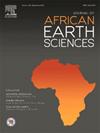Tidal facies analysis and 3D static modeling of the Cenomanian Lower Bahariya reservoir, Qasr Field, North Western Desert, Egypt
IF 2.2
4区 地球科学
Q2 GEOSCIENCES, MULTIDISCIPLINARY
引用次数: 0
Abstract
Facies heterogeneity of the Lower Bahariya sandstone reservoir in the Qasr Field led to challenges in the hydrocarbon exploration and field development. In this study, we integrated sedimentological and petrophysical analysis of conventional core data and wireline logs to construct a 3D static model that predicts the reservoir facies and properties variations in the study area. Detailed sedimentary facies analysis allowed to define eleven sedimentary facies types of three main facies associations: tidal channel, tidal sand bars, and tidal flat complex including bioclastic carbonate accumulations. These facies developed within a transgressive tide-influenced estuarine system. Porosity-permeability data of the interpreted facies reveals that both the tidal sand bars and channels are of good reservoir quality in comparison to the tidal flat heterolithics, and the carbonates that are non-reservoir facies. Both the lower parts of the tidal sand bars and the upper parts of the tidal channels show a relatively lower reservoir quality (ɸ<13 %, K < 1mD) due to increased argillaceous and calcareous cement content. Spatial distribution of the reservoir properties in the 3D geo-cellular static model confirms that the main producing tidal sand bars extend NW-SE, parallel to the fault system. These bars have an excellent reservoir quality in the west that deteriorates towards the east associated with facies change to heterolithic tidal flat facies. Hydrocarbon accumulation was identified within the central part of the study area, particularly within the tidal sand bar facies. The findings of this study shed light on the Lower Bahariya lateral and vertical reservoir distribution and quality, reducing uncertainty in the field development, and providing applicable knowledge for similar heterogeneous tidal hydrocarbon reservoirs.
求助全文
约1分钟内获得全文
求助全文
来源期刊

Journal of African Earth Sciences
地学-地球科学综合
CiteScore
4.70
自引率
4.30%
发文量
240
审稿时长
12 months
期刊介绍:
The Journal of African Earth Sciences sees itself as the prime geological journal for all aspects of the Earth Sciences about the African plate. Papers dealing with peripheral areas are welcome if they demonstrate a tight link with Africa.
The Journal publishes high quality, peer-reviewed scientific papers. It is devoted primarily to research papers but short communications relating to new developments of broad interest, reviews and book reviews will also be considered. Papers must have international appeal and should present work of more regional than local significance and dealing with well identified and justified scientific questions. Specialised technical papers, analytical or exploration reports must be avoided. Papers on applied geology should preferably be linked to such core disciplines and must be addressed to a more general geoscientific audience.
 求助内容:
求助内容: 应助结果提醒方式:
应助结果提醒方式:


